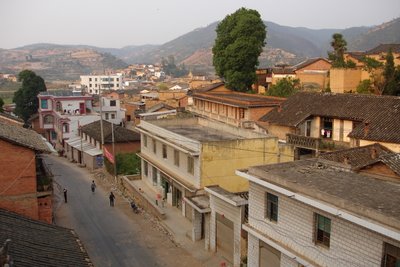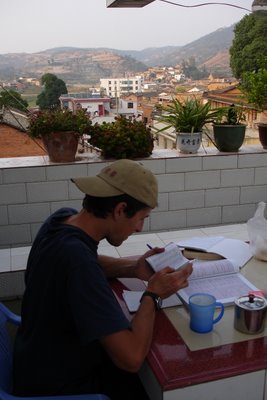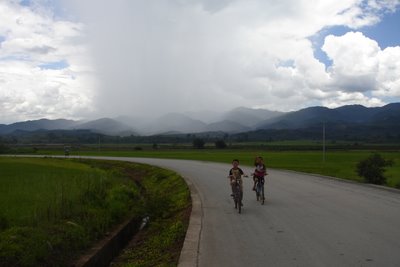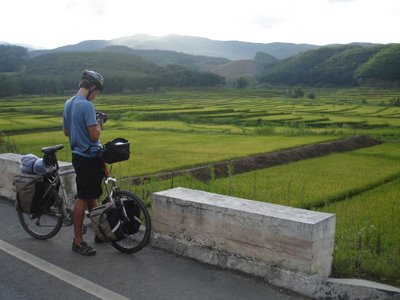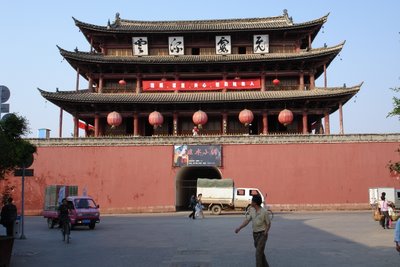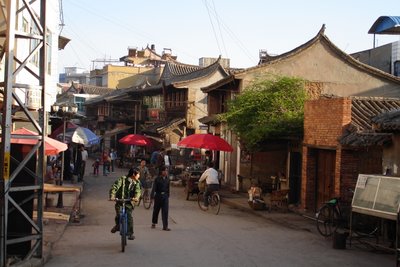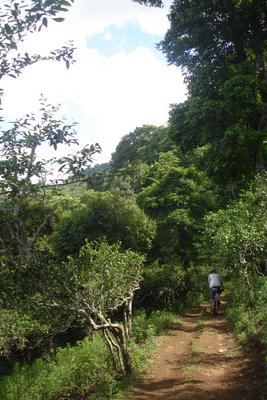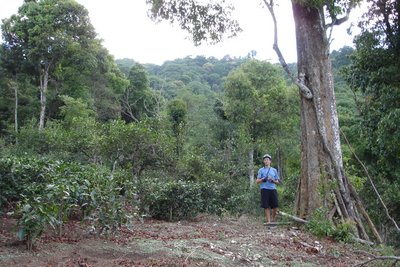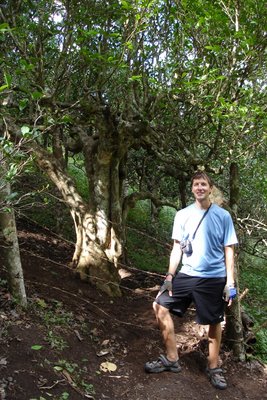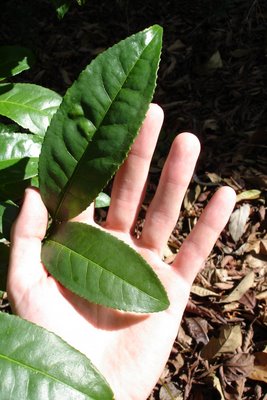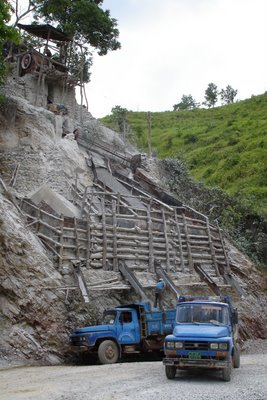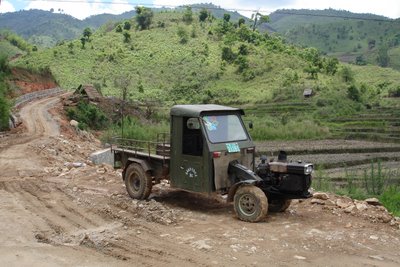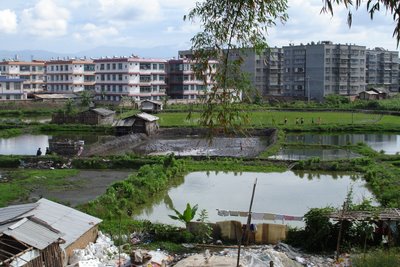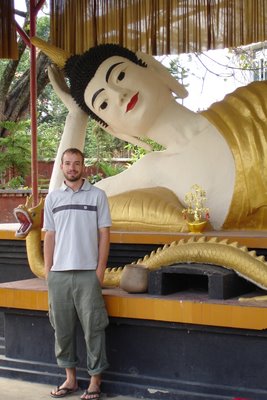Well, finally some time to update this with those pics/stories I promised...
This may be a bit over informative for some, as I will try to make this a place where people who want to do the same trip can get some information (I get some strange hits from google). I will probably add more information in the next week.
Contrary to what others have written on the net, this trip is possible year round. Usually the boats travel from Chiang Saen to JingHong. This time of year though (the dry seaon - anytime from February to early July we were told) the trip will only go as far an GuanLei in YunNan. From GuanLei it is a 5 hour bus ride to JingHong, or two days on a bike.
From July to December, this river trip can be done in two days and two nights. The risk of doing it late in the dry season is that it's possible that the trip will take longer. Possibly a lot longer. Our captain told us that the last trip took him 16 days... if we weren't too scared, we were welcome to come aboard.
The Chinese government controls the dam that controls the flow of water, so if you decide to do this trip in the dry season, you may find yourself anchored somewhere between here and nowhere (as we found ourselves doing a couple of afternoons) waiting for the water to come up. I can tell you that it comes up pretty slow.
Because this trip can take a lot longer in the dry season, the boat captains will try to charge more. We read on the net that 300 yuan was a pretty standard fare, but we met one cyclist in Lao who paid 600, and another guy who had paid 400. So, you're going to need to bargain. Our captain started at 500... eventually he explained that the trip could take a long long time, and he would need to feed us during that time. Food costs money. Eventually we worked out a deal where we would pay 350 if the trip was 3 days or less, 400 if it was 4 or 5 days, and 500 if it was more than five days. Seemed reasonable. Payment to be made on arrival!
Actually, when we got to Chiang Saen, the only boat in port was heading to Myanmar. The captain of that boat informed us that there were 5 boats 10 km up river at the Golden Triangle, and sure enough there were. Don't rely on Thai Immigration for information about the boats; they have no idea. So, if you don't find any boats in Chiang Saen, you know what to do. We headed up the road and arranged passage. Then the captain of that boat found a car and drove us back to Chiang Saen where we went through immigration and formally "departed" Thailand. At this point we walked out of immigration back onto the street - countryless - and drove back to the boat.
Anyway, here are some pictures.
 Ahh... yes. This is the boat. mmm hmmm. Nice one. Up top, behind the front deck you can see four windows of the living quarters... There were eight rooms, each with four beds... This boat is called 红星号 or "The Red Star".
Ahh... yes. This is the boat. mmm hmmm. Nice one. Up top, behind the front deck you can see four windows of the living quarters... There were eight rooms, each with four beds... This boat is called 红星号 or "The Red Star".
These Thai labourers loaded up the boat - shouldering three 10 kg boxes of dry Longyan (a fruit... aka "dragon eyes") down the hill - for about 8 hours.
 We left just after dark and travelled for about four hours in the dark using spot lights... I took this picture early the next morning just after we set off. That's the cook (or "the boy" as Brett and I named him) swabin' the deck. We would usually travel until 9 or 10 in the evening before ancoring for a good nights sleep. The crew would get up at around 5:00 am, and we would set off before the sun rose.
We left just after dark and travelled for about four hours in the dark using spot lights... I took this picture early the next morning just after we set off. That's the cook (or "the boy" as Brett and I named him) swabin' the deck. We would usually travel until 9 or 10 in the evening before ancoring for a good nights sleep. The crew would get up at around 5:00 am, and we would set off before the sun rose.
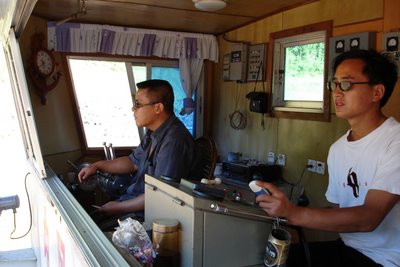 On the bridge: "Mi se de" Yang at the wheel and I can't remember his name on the throttle. There was a huge poster of Mao on the door behind Mr. Yang that I wish I could have gotten in this picture.
On the bridge: "Mi se de" Yang at the wheel and I can't remember his name on the throttle. There was a huge poster of Mao on the door behind Mr. Yang that I wish I could have gotten in this picture.
When we went through a shallow section, two of the guys would stand at the front of the barge and probe the water with long bamboo poles, yelling out directions as we inched up the river. We were frequently beached on sand bars, and twice we had to just stop all together and wait for an indefinate time. During these times, the captain would come and give us doomsday predictions about how the trip would probably take 8 to 10 days. He was serious.
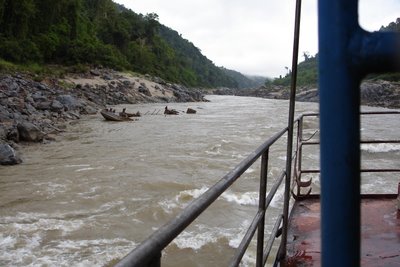 This was a crazy rapids section where the water flowed so fast that we needed the winch to pull the boat through. The barge had a winch up front powered by a huge deisel engine. Four or five members of the crew got off the boat and dragged the cable a hundred meters up stream where they found a suitably big rock. We inched up stream with the winch and the boats two engines all at full throttle. It was a little hairy. I guess that barge above didn't make it.
This was a crazy rapids section where the water flowed so fast that we needed the winch to pull the boat through. The barge had a winch up front powered by a huge deisel engine. Four or five members of the crew got off the boat and dragged the cable a hundred meters up stream where they found a suitably big rock. We inched up stream with the winch and the boats two engines all at full throttle. It was a little hairy. I guess that barge above didn't make it.
 Here are a couple of barges parked early morning on the Lao side of the river.
Here are a couple of barges parked early morning on the Lao side of the river.
A couple hours later, while I was reading on deck, I saw a bloated dead body eddying on the side of the river. Rough.
We kept on moving.
What to do? Did the crew see it? I have to say, I paniced a little (it's not everyday you see such a thing). I spent a minute or two working out what I was going to say to the captain. I went to the bridge and knocked on the door. I said something like "你们有没有看到水里的人? 他死掉了!" "Did you see that guy in the the water? He was dead!"
"Mmmm", they said. "He was probably having a bath and fell in".
We continued up the river.
I asked what we should do.
They said no problem, it was taken care of.
It was left at that.
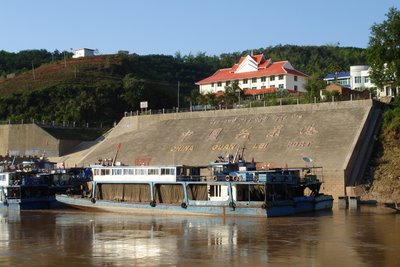 The last morning of the trip, at least 100 km south of China, we woke up to find the Mekong raging. The water had risen at least a meter over night. The dam had been opened. Everyone was pretty excited. High water means a lot less work for the crew.
The last morning of the trip, at least 100 km south of China, we woke up to find the Mekong raging. The water had risen at least a meter over night. The dam had been opened. Everyone was pretty excited. High water means a lot less work for the crew.
After exactly 3 days and 3 nights, we made it to GuanLei. The crew invited us to stay another night on the boat, and to head out for a night on the town. Before we got off the boat, we had a huge meal with six or seven dishes. They offered, and we drank a big glass of 百酒 (bai jiu, the strongest fire water I've ever drank) to toast the trip. Later we went into town to look around and play some pool. It was a great introduction to China.
You can check out Brett's blog for another version of this...
In the next posting I will explain how we learn Chinese by watching Chinese soap operas. Interesting and educational.




